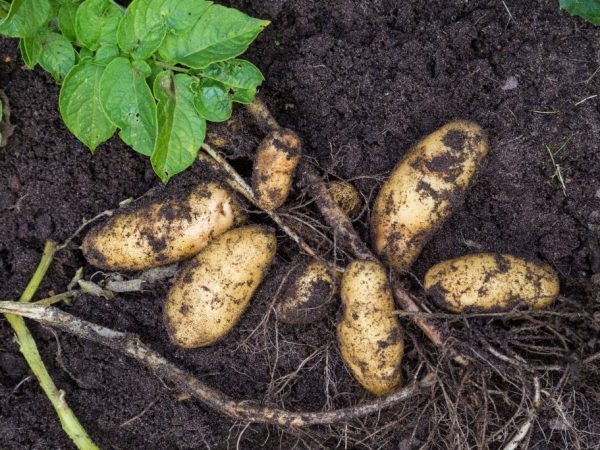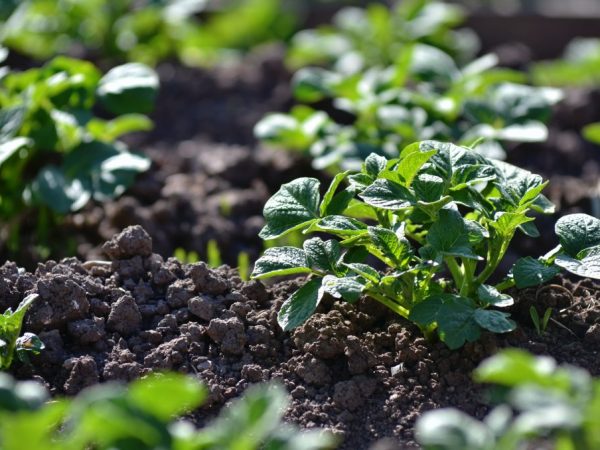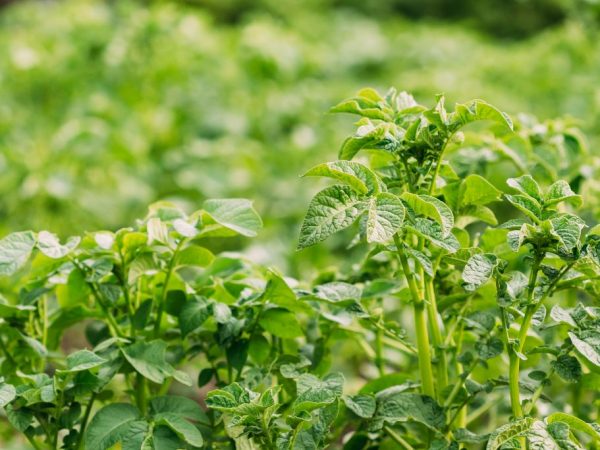Description of potatoes Granada
Every year more and more improved potato crops appear on the market. One of the new, high-yielding species is the Granada potato. It was bred in 2015 by German breeders.

Description of potatoes Granada
Characteristic
Potatoes Granada are considered promising varieties of table purposes. The species is popular in Western European countries and in the post-Soviet space. The height of the bushes will depend on the quality indicators of the soil. This type of potato responds well to regular feeding.
The Granada potato belongs to the late varieties. Ripens in 3.4 months from the date of planting. It tolerates temperature extremes and drought well.
Description of the plant
Subject to all the rules of agricultural technology, the bush can reach 90 cm, on depleted soils, the height of the bush will reach 35 cm.
Potatoes Granada description and characteristics of the variety:
- erect bushes, with dense foliage;
- inflorescences consist of 4-6 buds, white flowers;
- from 1 bush, you can collect 14-20 tubers.
Description of the fetus
The root crop can be characterized as follows:
- root crops are large, even, oblong;
- the skin is thin, light yellow in color;
- the flesh on the cut is yellow;
- the pulp does not lose its color when damaged and heat treated;
- the starch content in potatoes is 10-13%;
- on average, 1 root vegetable weighs 100 g.
Advantages and disadvantages
The Granada potato variety quickly adapts to all climates. It can grow on any type of soil, but the largest yield is obtained on sandy loam soils. The main advantage of the new species is its high resistance to many diseases of nightshade crops:
- golden nematode;
- phytophthora;
- potato crayfish;
- foliage curl virus;
- scab;
- rot.
Granada potatoes are well stored, resistant to mechanical damage, and therefore easily transported over long distances. Among the shortcomings, the demanding variety for fertilization is noted. In addition, it can be exposed to fusarium and attacks of the Colorado potato beetle.
Growing

Plant in sunny areas
In many ways, the yield depends on the quality of the soil. On depleted, not fertile soils, you need to apply more fertilizer or use non-standard planting methods. Depending on the quality of the soil, the width between the bushes will vary from 40 to 60 cm.
The new potato variety Granada is classified as an unpretentious, drought-resistant variety. To get a good harvest, you need to follow the rules of agricultural technology and apply fertilizers on time. You need to plant potatoes in open, well-lit areas.
Soil preparation
All preparatory work begins in the autumn, after the harvest. From the site you need to collect all the roots, tops and remove weeds.Then deep cultivation is carried out and organic fertilizers are applied.
In the spring, the land is cultivated again, but already before planting, so that the topsoil is not too dry. Mineral fertilizers and ash are introduced. If the soil is acidic, then dolomite flour is used instead of ash.
Seed preparation
They begin to prepare potatoes for planting immediately after harvesting. The smoothest tubers, large in size, should be selected. While medium-sized root crops are usually selected for growing other varieties, Granada is grown from the largest potatoes that can give a good harvest.
If you take small tubers, the yield will decrease significantly. If sprouts appear on seed potatoes during winter, it is better to remove them. In the spring, the seed should be taken out of the vegetable store and treated with disinfectants. In the future, germination is carried out in one of the most suitable ways.
Landing
The potato variety Granada begins to be planted when the soil warms up by at least 8 ℃. Planting Granada potatoes can be done in 2 ways:
- plant seeds in open ground;
- germinate the seedlings and then transplant them to an open area.
In the first case, planting is carried out at the end of April. In the second, the roots are placed in containers with a peat-soil mixture. After the sprouts appear, they should be broken off and planted in soil, which consists of peat, sand and garden soil. The sprouts are deepened by 2/3.
Seedling boxes should be installed in a well-lit place and covered with foil on top. When the first shoots appear, the film is removed and the plants begin to harden little by little. The seedlings are ready for transplanting to an open area in a month. This growing method can increase yields by 40%.
The planting method will depend entirely on the quality of the soil and the weather. In areas with a warm, dry climate and light soil, you can plant potatoes in holes or furrows to a depth of 10 cm.On loose, fertile soils, the planting depth will be 5 cm.In areas with heavy, moist soil, ridges are made to raise the bushes above surface of the earth. On loams, the recommended planting depth is no more than 5 cm.
A distance of 65-70 cm is left between the rows. 0.5 tbsp is placed in each hole. wood ash. If it is not possible to get ash, you can use universal mineral complexes. When planting potatoes of this variety, it is forbidden to use fresh manure, otherwise the seed material may completely die.
Plant care

Plants need to be fertilized regularly
The characteristic of the species classifies the Granada potatoes as undemanding varieties. The species is drought-resistant, therefore, when there is a moderate amount of rain, you can not water at all until flowering. Plants are demanding on fertilization.
It is recommended to weed the soil between the rows several times per season, freeing it from weeds. Loosening the soil is an important step. This improves soil aeration and prevents moisture stagnation.
Hilling
This procedure should be carried out at least 2 times until the plants ripen. At the beginning, mounds of 10 cm are made, when sprouts appear 15 cm. The second time, hilling is carried out 3 weeks after the first.
On fertile soils, the bushes grow tall and branched. Hilling is necessary not only in order to protect the culture from possible frost, but also to form a neat bush. This procedure helps to increase yields. When hilling, additional underground stems are formed.
Top dressing
In total, from the moment of planting, fertilizer is applied 4 times. For the first time, use mineral mixtures or ash when planting. The soil is then fertilized 28 days after planting. Fertilized with urea, potassium sulfate or superphosphates.
The third time fertilization is applied at the time of bud formation and the fourth after flowering.It is recommended to use urea as fertilizer. Organic fertilizers should be used very carefully so as not to burn the roots. If this is a litter, add 0.5 kg to 10 liters of water and insist for a week. Then the plants are watered.
Diseases and prevention
The culture is often exposed to Alternaria, which affects all structural units of the plant, as well as Fusarium. Prevention is the treatment of tubers at the preparation stage. Then prophylactic treatment is carried out during planting and several times throughout the growing season. Before and during planting, use Baktofit or Planriz. During the growing season, Kuproksat and Profit are used.
The most malicious pest is considered the Colorado potato beetle, as well as the wireworm. Most often, Killer, Destroy, Gulliver and many others are used to prevent their appearance. A good effect is obtained by treating the site with herbicides at the time of soil preparation in the fall.
Harvesting and storage
The crop is ready for harvesting 120-140 days after planting. The bushes are carefully dug in and the tubers are selected manually. Immediately in the garden, the potatoes are sorted out, the damaged tubers are discarded.
For 2-3 hours, the tubers are kept outdoors. Then they are laid out in boxes and left for a couple of weeks in a dark room, gradually reducing the air temperature. Then they are sorted out again, the seed is folded separately, the spoiled tubers are rejected and lowered into the vegetable store.
It is recommended to spray the seed material with a solution of copper sulfate so that it is stored longer. Add 2 g of the preparation per 10 l of water. Throughout the winter period, it is necessary to inspect the tubers in order to reject spoiled ones.
Final part
The Granada potato appeared quite recently, but has already taken its place of honor among the best, high-yielding varieties. Potatoes have excellent taste, retain their color and shape after heat treatment, therefore they belong to the universal table varieties. The species is not picky about care.
Granada can grow on any type of soil. The highest yield is observed on light sandy loam soils. The culture is demanding for fertilization. The cultural characteristics attract many consumers. Many of those who have already tried it in practice were very pleased with its high yield and taste.


